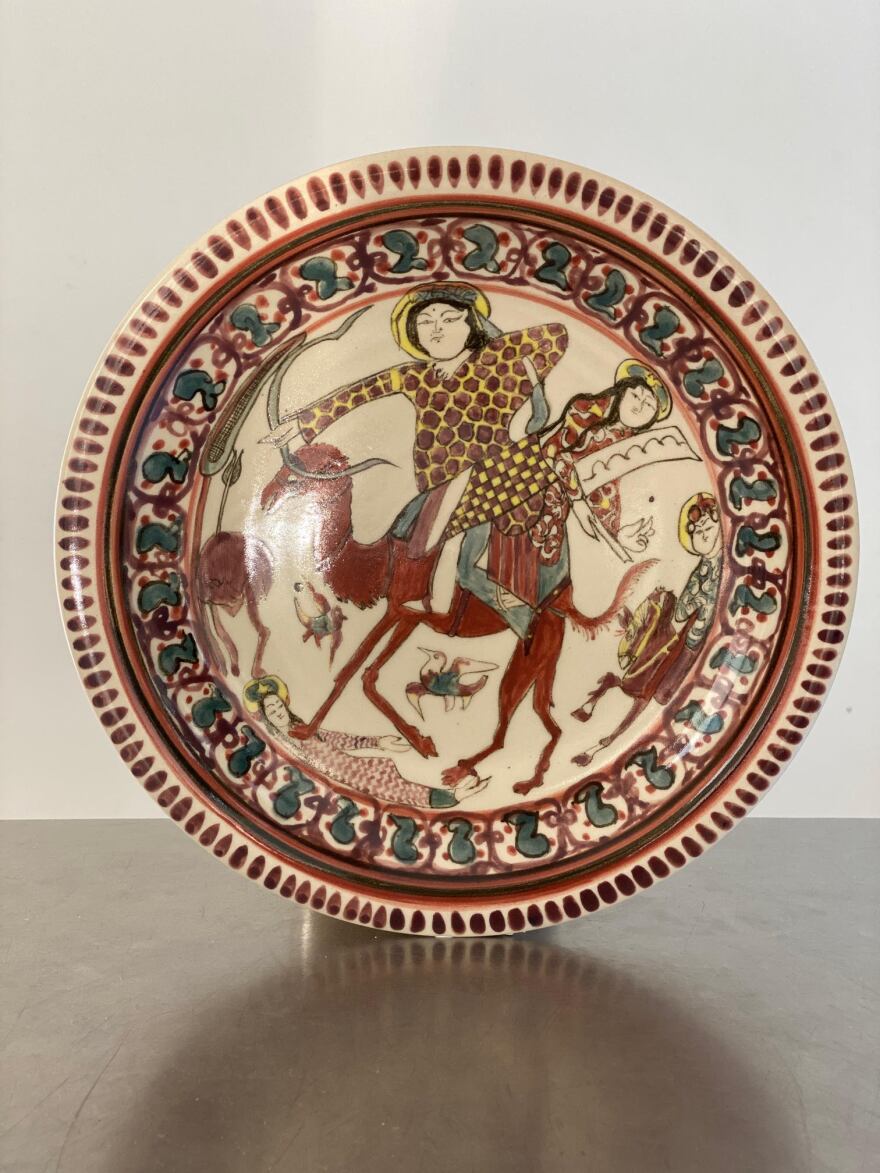In 2020, Naysan McIlhargey’s family planned to live in London for a year. His wife was in a Ph.D. program there. His plan was to make plates for London restaurants using a ceramics studio a mile from their flat. His brother who lives in London was ready to help sell the plates to the restaurants. “I had sent pots to two restaurants in England about three years earlier from Ohio,” says McIlhargey, “and so we even got to eat off of some of the plates that I had made here and sent ahead of time.”

McIlhargey started studying the ancient and medieval ceramics at the Victoria and Albert museum. His family heritage is in the Bahai faith from Iran, and his ancestors fled persecution after the 1979 Iranian revolution. The museum has a special room where a curator will let you handle selected pieces from the collection. McIlhargey got to hold a bowl from 13th century Iran. As he studied the intricate ornamentation, human figures, and mythical beasts in a bowl only 8 inches across, he admired the artist’s skill. Says McIlhargey, “I mean I would love to have met that person, to know who did it because technically it’s an incredible feat to pull it off.”
Looking at the bowl In his hands, he saw much more than when it was under glass. “I was really, really shocked and surprised by the number of pieces that these bowls were in, remarked McIlhargey,” “ I mean they were in hundreds of shards that were glued back together.”
Then came Covid. The restaurants were about to shut down. By this time, McIlhargey had made 85 plates which were still unglazed. He knew he had to get the plates out of the ceramics studio and into his family’s apartment, a mile away. He describes what he did then. “So I brought them with my little cart and made dozens of trips, and I learned which sidewalks to avoid because when you stack the plates like this, you have to be careful because they can break easily.”

He still didn’t’ know what to do with the plates. He did know he needed good brushes from different animal hairs. “It was literally like two nights before lockdown,” McIlhargey recalls. “I took the bus down to Chinatown, and I spent a ton of money on these brushes. I mean some of the brushes are just a few couple hairs thick, and it allowed me to do some of these really fine detailed pieces.”
He worked to create the figures from one of the bowls he had handled. He only had his phone to study the image. He found a 12th century bowl that depicts several rings of camels, men on horses, winged animals, all packed in just 8 inches across. “They had several images, McIlhargey remarks, “but they didn’t have every angle because every horse and horse-man person is different. They’re all different from one another, so it’s essential to see all the angles.”
McIlhargey approached this problem with a potter’s philosophy toward their art. He says : You have to give yourself to the fire and not depend on everything you have in mind. Things will happen in the kiln and have to be open to that. So the same is true when you’re looking at the image of a piece. If I don’t’ have the perfect view from every angle, it gives me a little bit of leeway, in terms of how I interpret the piece. “

McIlhargey created over 80 unique artworks, each based on a different ceramic from museums around the world. He says Covid made this possible. He suggests, “We can calm down during the pandemic and do things like this and slow down and pay attention to things that we might not normally see.”
McIlhargey has had two exhibits of the Persian Routes plates and hopes for more in the future. He wants Americans to see the richness of Iranian culture. For American families who fled Iran who have seen the show, it touches them even more. McIlhargey says that the show “conjures to them a comfort of imagery that’s part of the culture to them, memories of their childhood, imagery from stories. It’s something they may have seen in their lives, especially back in Iran, that maybe they haven’t seen since they’ve been here.”
For more information about the Persian Routes plates, see the website for Miami Valley Pottery.
Support for Culture Couch comes from WYSO Leaders Frank Scenna and Heather Bailey, who are proud to support storytelling that sparks curiosity, highlights creativity and builds community.
Culture Couch is created at the Eichelberger Center for Community Voices at WYSO.


